You Only Live Twice (film)
You Only Live Twice is a 1967 spy film and the fifth in the James Bond series produced by Eon Productions, starring Sean Connery as the fictional MI6 agent James Bond. It is the first Bond film to be directed by Lewis Gilbert, who later directed the 1977 film The Spy Who Loved Me and the 1979 film Moonraker, both starring Roger Moore. The screenplay of You Only Live Twice was written by Roald Dahl, and loosely based on Ian Fleming's 1964 novel of the same name. It is the first James Bond film to discard most of Fleming's plot, using only a few characters and locations from the book as the background for an entirely new story.
| You Only Live Twice | |
|---|---|
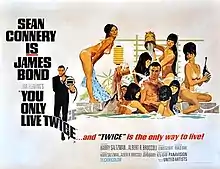 Theatrical release poster by Robert McGinnis and Frank McCarthy | |
| Directed by | Lewis Gilbert |
| Produced by | Harry Saltzman Albert R. Broccoli |
| Screenplay by | Roald Dahl |
| Additional story material by | |
| Based on | You Only Live Twice by Ian Fleming |
| Starring | Sean Connery |
| Music by | John Barry |
| Cinematography | Freddie Young |
| Edited by | Peter R. Hunt |
Production company | |
| Distributed by | United Artists |
Release date |
|
Running time | 117 minutes |
| Country | United Kingdom[1] United States[2] |
| Language | English Japanese |
| Budget | $9.5 million[3] |
| Box office | $111.6 million |
In the film, Bond is dispatched to Japan after American and Soviet crewed spacecraft disappear mysteriously in orbit, each nation blaming the other amidst the Cold War. Bond travels secretly to a remote Japanese island to find the perpetrators, and comes face-to-face with Ernst Stavro Blofeld, the head of SPECTRE. The film reveals the appearance of Blofeld, who was previously a partially unseen character. SPECTRE is working for the government of an unnamed Asian power, implied to be the People's Republic of China, to provoke war between the superpowers.[4][5]
During the filming in Japan, it was announced that Sean Connery would retire from the role of Bond, but after one film's absence, he returned in 1971's Diamonds Are Forever and later 1983's non-Eon Bond film Never Say Never Again. You Only Live Twice was a great success, receiving positive reviews and grossing over $111 million in worldwide box office. However, the film was the first in the series to have a decline in box-office revenue owing to the over-saturation of the spy movie genre contributed to by the franchise's imitators including the recent competing film, the poorly received competing licensed James Bond film, Casino Royale, from Columbia Pictures that was released previously in the same year.[6]
Plot
American NASA spacecraft Jupiter 16 is hijacked from orbit by an unidentified spaceship. The United States suspects it to be the work of the Soviets, but the British suspect Japanese involvement since the spacecraft, after having "swallowed" Jupiter 16, landed in the Sea of Japan. To investigate, MI6 operative James Bond is sent to Tokyo, after faking his own death in Hong Kong and being buried at sea from HMS Tenby.
Upon his arrival, Bond attends a sumo match where he is approached by Japanese secret service agent Aki, who takes him to meet local MI6 operative Dikko Henderson. Henderson claims to have critical evidence about the rogue craft, but is killed before he can elaborate. Bond chases and kills the assailant, taking the assailant's clothing as a disguise, and is driven in the getaway car to Osato Chemicals. Once there, Bond subdues the driver and breaks into the office safe of the company's president, Mr. Osato. After obtaining secret documents, Bond is pursued by armed security, but is rescued by Aki, who flees to a secluded subway station. Bond chases her, but falls down a trap door leading to the office of the head of the Japanese secret service, Tiger Tanaka. The stolen documents are examined, and found to include a photograph of the cargo ship Ning-Po, with a microdot message saying the tourist who took the photo was killed as a security precaution. While at Tanaka's spa, Bond meets with Aki again. Having developed feelings for each other, the pair kiss and Bond carries Aki to his bed.
Bond goes back to Osato Chemicals to meet Mr. Osato himself, masquerading as a potential new buyer. Osato humours Bond, but after their meeting, he orders his secretary, Helga Brandt, to have him killed; both are revealed to be SPECTRE agents. Outside the building, assassins open fire on Bond before Aki rescues him again. Bond and Aki drive to Kobe, where the Ning-Po is docked. They investigate the company's dock facilities, and discover that the ship was delivering elements for rocket fuel. They are discovered, but Bond eludes the henchmen until Aki gets away; however, Bond is captured. He wakes, tied up in Brandt's cabin on the Ning-Po. Brandt interrogates Bond, before seducing him. Brandt flies Bond to Tokyo the next day, but en route, she sets off a flare in the plane, seals Bond in his seat and bails out, assuming Bond will die in the crash. Bond manages to evade the trap, lands the plane and flees before it explodes.
After finding out where the Ning-Po unloaded, Bond flies over the area in a heavily armed autogyro created by Q, called 'Little Nellie'. Near a volcano, Bond is attacked by four helicopters, which he defeats thanks to the array of weaponry, confirming his suspicions that the enemy's base is nearby. A Soviet spacecraft is then captured in orbit by another unidentified craft, heightening tensions with the United States. The mysterious spaceship lands in an extensive base hidden inside the volcano. It soon turns out that the true mastermind behind this is Ernst Stavro Blofeld, the mysterious leader of SPECTRE who has been hired by a great power (strongly implied to be the People's Republic of China) to start a Soviet-American war, in order for them to destroy each other so that China can replace them as the world's new superpower. Blofeld summons Osato and Brandt to his office to answer for not having killed Bond; Osato immediately blames his assistant, Brandt. Blofeld gives them a last chance, but as Brandt leaves, he activates a mechanism that drops her to her death into a pool filled with piranhas. Blofeld then orders Osato to kill Bond.
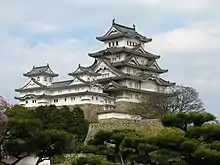
Bond then meets Tanaka and Aki in Kyoto where they plan to infiltrate the island by disguising Bond as a Japanese fisherman, alongside a wife amongst Tiger himself and 100 of his ninjas. Bond assumes his Japanese disguise however while still in Kyoto a SPECTRE assassin tries to poison him while he and Aki are sleeping together. Bond narrowly survives when the pair move in their sleep and Aki is killed instead.
Following a second attempt on his life by another assassin, Bond is introduced to Tanaka's student, Kissy Suzuki, who is to act as his wife. Acting on her lead, a funeral for an Ama girl who died recently, the pair reconnoitre a cave booby-trapped with poison, and the volcano above it. Establishing that the mouth of the volcano is a disguised hatch to the secret rocket base, Bond slips in, while Kissy goes to alert Tanaka. Bond locates and frees the captured American and Soviet astronauts and, with their help, steals a space suit in an attempt to infiltrate the SPECTRE spacecraft, "Bird One". However, Blofeld spots Bond mishandling his equipment, and he is detained while Bird One is launched with a backup astronaut. Bond is taken into the control room where he meets Blofeld face-to-face for the first time. Blofeld kills Osato to demonstrate the price of failure to kill Bond.
Bird One closes in on an American space capsule, and U.S. forces prepare to launch a nuclear attack on the USSR. Meanwhile, a team of Japanese ninjas trained by Tanaka approach the base's entrance, but are detected and fired upon. Bond manages to open the hatch, letting in the ninjas. During the ensuing battle, Bond fights his way back to the control room, kills Blofeld's bodyguard Hans by tossing him into the piranha pool, and activates Bird One's self-destruct before it reaches the American craft. The Americans promptly stand down their forces.
Blofeld activates the base's self-destruct system, a bomb that triggers a volcanic eruption, and escapes. Bond, Kissy, Tanaka, and the surviving ninjas leave before the eruption destroys the base, and are picked up by the Japanese Maritime Forces and the British Secret Service.
Cast
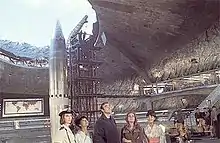
- Sean Connery as James Bond, an MI6 agent
- Akiko Wakabayashi as Aki, an agent with the Japanese SIS who assists Bond
- Mie Hama as Kissy Suzuki, an Ama diving girl who marries Bond as an undercover ploy
- Nikki van der Zyl (uncredited) as the voice of Kissy Suzuki
- Tetsurō Tamba as Tiger Tanaka, head of Japanese secret service
- Teru Shimada as Mr. Osato, a Japanese industrialist secretly affiliated to SPECTRE
- Karin Dor as Helga Brandt/No. 11, Osato's secretary and a SPECTRE assassin
- Donald Pleasence as Ernst Stavro Blofeld, the megalomaniacal head of the terrorist syndicate known as SPECTRE
- Bernard Lee as M, the head of MI6
- Lois Maxwell as Miss Moneypenny, M's secretary
- Desmond Llewelyn as Q, head of MI6 technical department
- Charles Gray as Dikko Henderson, British contact living in Japan. Gray would later play Blofeld in Diamonds Are Forever, opposite Sean Connery.
- Tsai Chin as Chinese Girl (Hong Kong), Ling, undercover MI6 agent[7]
- Peter Fanene Maivia as Car Driver, one of Osato's henchmen, who fights Bond in Osato's office
- Burt Kwouk as Spectre Number 3, one of Blofeld's henchmen. Kwouk had previously played the Chinese agent Mr. Ling in Goldfinger.
- Michael Chow as Spectre 4, one of Blofeld's henchmen and Mr Osato's secretary
- Ronald Rich as Blofeld's bodyguard, Hans
- David Toguri as Assassin (Bedroom), one of Osato's henchmen, who kills Aki
- John Stone as Submarine Captain
- Norman Jones as Astronaut – 1st American Spacecraft
- Paul Carson as Astronaut – 1st American Spacecraft
- Laurence Herder as Cosmonaut – Soviet Spacecraft
- Richard Graydon as Cosmonaut – Soviet Spacecraft
- Bill Mitchell as Astronaut – 2nd American Spacecraft
- George Roubicek as Astronaut – 2nd American Spacecraft
- Alexander Knox as the US President
- Ed Bishop (uncredited) as NASA Hawaii technician, who warns 1st American spacecraft of approaching unidentified craft.[8] Bishop would later play the also uncredited role of Klaus Hergersheimer in Diamonds Are Forever.
- Frazer Hines (uncredited) as Spectre Number 4 (Mr. Osato's Secretary) (voice)
- Shane Rimmer (uncredited) as NASA Hawaii technician. This was Rimmer's first contribution to the Bond franchise, as he would later appear as Tom in Diamonds Are Forever (uncredited), Live and Let Die (albeit as a voice and uncredited) and as Commander Carter in The Spy Who Loved Me.
- Richard Marner (uncredited) as Soviet Controller
- Anthony Ainley (uncredited) as Hong Kong Policeman
Production

On Her Majesty's Secret Service was the intended next film after Thunderball (1965), but the producers decided to adapt You Only Live Twice instead because OHMSS would require searching for high and snowy locations.[10] Lewis Gilbert originally declined the offer to direct, but accepted after producer Albert R. Broccoli called him saying: "You can't give up this job. It's the largest audience in the world." Peter R. Hunt, who edited the first five Bond films, believed that Gilbert had been contracted by the producers for other work but they found they had to use him.[11]
Gilbert, producers Broccoli and Harry Saltzman, production designer Ken Adam and director of photography Freddie Young then went to Japan, spending three weeks searching for locations. SPECTRE's shore fortress headquarters was changed to an extinct volcano after the team learned that the Japanese do not build castles by the sea. The group was due to return to the UK on a BOAC Boeing 707 flight (BOAC Flight 911) on 5 March 1966, but cancelled after being told they had a chance to watch a ninja demonstration.[10] That flight crashed 25 minutes after takeoff, killing all on board.[12] In Tokyo, the crew also found Hunt, who decided to go on holiday after having his request to direct declined. Hunt was invited to direct the second unit for You Only Live Twice and accepted the job.[13]
Unlike most James Bond films, which usually feature various locations around the world, almost the entire film is set in one country, and several minutes are devoted to an elaborate Japanese wedding. This is in keeping with Fleming's original novel, which also devoted a number of pages to the discussion of Japanese culture. Toho Studios provided soundstages, personnel, and the female Japanese stars to the producers.[14]
Writing
The producers had Harold Jack Bloom come to Japan with them to write a screenplay. His work was ultimately rejected, but since several of his ideas were used in the final script, he was given the credit of "Additional Story Material".[15] Among these elements were the opening with Bond's fake death and burial at sea, and the ninja attack.[16] As the screenwriter of the previous Bond films, Richard Maibaum, was unavailable, Roald Dahl (a close friend of Ian Fleming) was chosen to write the adaptation, despite having no prior experience writing a screenplay except for the uncompleted The Bells of Hell Go Ting-a-ling-a-ling.[10]
Dahl said that the original novel was "Fleming's worst book, with no plot in it which would even make a movie",[16] and compared it to a travelogue,[17] stating that he had to create a new plot though "I could retain only four or five of the original story's ideas."[18] On creating the plot, Dahl said he "did not know what the hell Bond was going to do" despite having to deliver the first draft in six weeks, and decided to do a basic plot similar to Dr. No.[16] Dahl was given a free rein on his script, except for the character of Bond and "the girl formula", involving three women for Bond to seduce — an ally and a henchwoman who both get killed, and the main Bond girl. While the third involved a character from the book, Kissy Suzuki, Dahl had to create Aki and Helga Brandt to fulfil the rest.[19]
Gilbert was mostly collaborative with Dahl's work, as the writer declared: "He not only helped in script conferences, but had some good ideas and then left you alone, and when you produced the finished thing, he shot it. Other directors have such an ego that they want to rewrite it and put their own dialogue in, and it's usually disastrous. What I admired so much about Lewis Gilbert was that he just took the screenplay and shot it. That's the way to direct: You either trust your writer or you don't."[16] Charles Gray, who played Dikko Henderson, actually says the famous "shaken not stirred" line the other way round saying "that is stirred not shaken, that was right wasn't it?" Bond replies "Perfect."
Casting
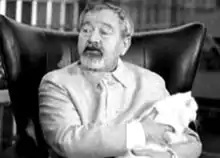
When the time came to begin You Only Live Twice, the producers were faced with the problem of a disenchanted star. Sean Connery had stated that he was tired of playing James Bond and all of the associated commitment (time spent filming and publicising each movie), together with finding it difficult to do other work, which would potentially lead to typecasting.[15][20] Saltzman and Broccoli were able to persuade Connery by increasing his fee for the film, but geared up to look for a replacement.
Jan Werich was originally cast by producer Harry Saltzman to play Blofeld. Upon his arrival at the Pinewood set, both producer Albert R. Broccoli and director Lewis Gilbert felt that he was a poor choice, resembling a "poor, benevolent father Christmas". Nonetheless, in an attempt to make the casting work, Gilbert continued filming. After several days, both Gilbert and Broccoli determined that Werich was not menacing enough, and recast Blofeld with Donald Pleasence in the role.[10] Pleasence's ideas for Blofeld's appearance included a hump, a limp, a beard, and a lame hand, before he settled on the scar.[21] He found it uncomfortable, though, because of the glue that attached it to his eye.[22]
Many European models were tested for Helga Brandt, including German actress Eva Renzi who passed on the film,[23] with German actress Karin Dor being cast. Dor performed the stunt of diving into a pool to depict Helga's demise, without the use of a double.[24] Strangely, for the German version, Dor was dubbed by someone else.[25]
Gilbert had chosen Tetsurō Tamba after working with him in The 7th Dawn. A number of martial arts experts were hired as the ninjas. The two Japanese female parts proved difficult to cast, due to most of the actresses tested having little English. Akiko Wakabayashi and Mie Hama, both Toho stars, were eventually chosen and started taking English classes in the UK. Hama, initially cast in the role of Tanaka's assistant, had difficulty with the language, so the producers switched her role with Wakabayashi, who had been cast as Kissy, a part with less dialogue. Wakabayashi only requested that her character name, "Suki", be changed to "Aki".[10]
Filming
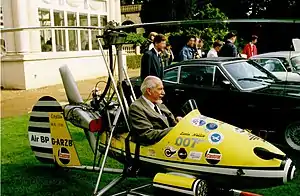
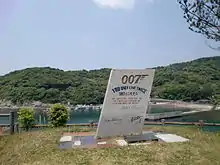
Filming of You Only Live Twice lasted from July 1966 to March 1967.[26]
The film was shot primarily in Japan, and most of the locations are identifiable.[27]
In summary:
- Tokyo: After arriving in Japan at Akime, Bond goes to Tokyo. The initial scenes are set in and around the Ginza area. The Hotel New Otani Tokyo served as the outside for Osato Chemicals, and the hotel's gardens were used for scenes of the ninja training. A car chase using the Toyota 2000GT and a Toyota Crown was largely filmed in the area around the Olympic Stadium used previously for the 1964 Summer Olympics. Tokyo Tower and the center of Tokyo can be briefly seen in a sequence where the villain's car is dropped in Tokyo Bay. Tanaka's private subway station was filmed at the Tokyo Metro's Nakano-shimbashi Station. A sumo wrestling match was filmed at Tokyo's sumo hall, the Kuramae Kokugikan; this has since been demolished.
- Kobe Docks appears in a sequence when Bond investigates the ship Ning-Po, and is involved in a fight.
- Bond's wedding at a Shinto Shrine was filmed in Nachi.
- Himeji Castle in Hyōgo Prefecture was depicted as Tanaka's ninja training camp.
- The village of Bonotsucho Akime was where Bond and his Ama wife lived and where the Ama scenes were shot.
- The ryokan Shigetomi-so (now known as Shimazu Shigetomisoh Manor) was used as the exterior of Tanaka's house.
- Kagoshima Prefecture was the location for various scenes depicting Little Nellie (see below).
- Mount Shinmoe-dake in Kyūshū was used for the exteriors of SPECTRE's headquarters.[10][28][29]
Most of the interiors were shot at Pinewood. The opening sequence in Hong Kong used some location footage of a street in Kowloon. Hong Kong's Victoria Harbour is also shown, but the at-sea burial of Bond and the retrieval of the corpse was filmed off Gibraltar and the Bahamas. The scenes with the light aircraft ferrying Bond to his supposed death were shot over very English-looking countryside in Buckinghamshire, whereas this was supposed to be Japan.[27]
Large crowds were present in Japan to see the shooting. A Japanese fan began following Sean Connery with a camera, and police had to deal with fan incursions several times during shooting.[10][22]
The heavily armed WA-116 autogyro "Little Nellie" was included after Ken Adam heard a radio interview with its inventor, RAF Wing Commander Ken Wallis. Little Nellie was named after music hall star Nellie Wallace, who has a similar surname to its inventor. Wallis piloted his invention, which was equipped with various mock-up armaments by John Stears' special effects team, during production.[26]
"Nellie"'s battle with helicopters proved to be difficult to film. The scenes were initially shot in Miyazaki, first with takes of the gyrocopter, with more than 85 take-offs, five hours of flight and Wallis nearly crashing into the camera several times. A scene filming the helicopters from above created a major downdraft, and cameraman John Jordan's foot was severed by the craft's rotor. It was surgically reattached by surgeons visiting the country, and then amputated in London when the surgery was deemed to have been flawed.[30] Jordan would continue work for the Bond series with a prosthetic foot. The concluding shots involved explosions, which the Japanese government did not allow in a national park; hence, the crew moved to Torremolinos, Spain, which was found to resemble the Japanese landscape.[10] The shots of the volcano were filmed at Shinmoedake on Kyushu Island.[31]
The sets of SPECTRE's volcano base, including operative heliport and monorail, were constructed at a lot inside Pinewood Studios, at a cost of $1 million.[10][28] The 45 m (148 ft) tall set could be seen from 5 kilometres (3 miles) away, and attracted many people from the region.[32] Locations outside Japan included using the Royal Navy frigate HMS Tenby, then in Gibraltar, for the sea burial,[33] Hong Kong for the scene where Bond fakes his death, and Norway for the Soviet radar station.[10][29][32]
Sean Connery's then-wife Diane Cilento performed the swimming scenes for at least five Japanese actresses, including Mie Hama.[10] Martial arts expert Donn F. Draeger provided martial arts training, and also doubled for Connery.[34] Lewis Gilbert's regular editor, Thelma Connell, was originally hired to edit the film. However, after her initial, almost three-hour cut received a terrible response from test audiences, Peter R. Hunt was asked to re-edit the film. Hunt's cut proved a much greater success, and he was awarded the director's chair on the next film as a result.[15]
Music
The soundtrack was the fourth of the series to be composed by John Barry. He tried to incorporate the "elegance of the Oriental sound" with Japanese music-inspired tracks.[35] The theme song, "You Only Live Twice", was composed by Barry and lyricist Leslie Bricusse, and sung by Nancy Sinatra after her father Frank Sinatra passed on the opportunity.[36] Nancy Sinatra was reported to be very nervous while recording — first she wanted to leave the studio; then she claimed to sometimes "sound like Minnie Mouse".[37] Barry declared that the final song uses 25 different takes.
There are two versions of the song "You Only Live Twice", sung by Nancy Sinatra, one directly from the movie soundtrack, and a second one for record release arranged by Billy Strange. The movie soundtrack song is widely recognised for its striking opening bars and oriental flavour, and was far more popular on radio. The record release reached No. 44 on the Billboard charts in the USA, and No. 11 in the UK. Both versions of the title song are available on CD.
A different title song was originally recorded by Julie Rogers, but eventually discarded.[36] Only two lines from that version were kept in the final lyrics, and the orchestral part was changed to fit Sinatra's vocal range. Rogers' version only appeared in a James Bond 30th Anniversary CD, with no singer credit.[38][39][40] In the 1990s, an alternative example of a possible theme song (also called "You Only Live Twice" and sung by Lorraine Chandler) was discovered in the vaults of RCA Records. It became a very popular track with followers of the Northern soul scene (Chandler was well known for her high-quality soul output on RCA) and can be found on several RCA soul compilations.[41]
Promotion
To promote the film, United Artists Television produced a one-hour color television programme titled Welcome to Japan, Mr. Bond, which first aired on 2 June 1967 in the United States on NBC.[42] Bond regulars Lois Maxwell and Desmond Llewelyn appeared, playing respectively Miss Moneypenny and Q. Kate O'Mara appears as Miss Moneypenny's assistant.[43] The programme shows clips from You Only Live Twice and the then four existing Bond films, and contained a storyline of Moneypenny trying to establish the identity of Bond's bride.[44]
Release and reception
You Only Live Twice premiered at the Odeon Leicester Square in London on 12 June 1967, with Queen Elizabeth II in attendance.[45] The film opened the following day in the United Kingdom and United States, set an opening day record at the Odeon Leicester Square, and went to number one in the United States with a weekend gross of $600,000.[45] It grossed $7 million from 161 theaters in the United States in its first three weeks,[45] and was number one for seven weeks.[46] The film grossed $43 million in the United States and over $68 million worldwide.[47]
Contemporary reviews
Roger Ebert of the Chicago Sun-Times awarded the film two-and-a-half stars out of four, in which he criticised the focus on gadgets, declaring "the formula fails to work its magic. Like its predecessor Thunderball, another below-par entry, this one is top-heavy with gadgets but weak on plotting and getting everything to work at the same time."[48] Bosley Crowther, reviewing for The New York Times, felt "there's enough of the bright and bland bravado of the popular British super-sleuth mixed into this melee of rocket-launching to make it a bag of good Bond fun. And there's so much of that scientific clatter — so much warring of super-capsules out in space and fussing with electronic gadgets in a great secret underground launching pad—that this way out adventure picture should be the joy and delight of the youngsters and give pleasure to the reasonable adults who can find release in the majestically absurd."[49]
Variety stated more positively that "As entertainment [You Only Live Twice] compares favorably in quality and is replete with as many fights, gadgets, and beauties as its predecessors".[50] Time was sharply critical of the film claiming the franchise had become "the victim of the same misfortune that once befell Frankenstein: there have been so many flamboyant imitations that the original looks like a copy." The reviewer later derided that "the effects are ineffective. The outer-space sequences would be more appropriate in a grade school educational short entitled Our Amazing Universe, and the volcanic climax is a series of clumsy process shots that no one took the trouble to fix. Even Connery seems uncomfortable and fatigued..."[51] Clifford Terry, reviewing for the Chicago Tribune, remarked that "a large percentage of You Only Live Twice is disappointing, lacking the wit and zip, the pacing and punch, of its predecessors, especially the first three. Roald Dahl's script is larded with sex-slanted jokes that are either pathetically feeble or sophomorically coarse, Bond's patented puns are punier and even Connery's enthusiasm for his shrewd, suave, and sensual character seems to have waned."[52]
Retrospective reviews
On the review aggregation website Rotten Tomatoes, the film holds an approval rating of 73% based on 49 reviews with an average rating of 6.53/10. The website's critical consensus reads, "With exotic locales, impressive special effects, and a worthy central villain, You Only Live Twice overcomes a messy and implausible story to deliver another memorable early Bond flick."[53] James Berardinelli of ReelViews said that the first half was good, but "It's only during the second half, as the plot escalates beyond the bounds of preposterousness, that the film starts to fragment", criticising Blofeld's appearance and stating "rockets that swallow up spacecraft are a bit too extravagant."[54] Ali Barclay of BBC Films panned Dahl's script as displaying "a whole new world of villainy and technology".[55] Leo Goldsmith lauded the volcano base as "the most impressive of Ken Adam's sets for the franchise."[56] Danny Peary wrote that You Only Live Twice "should have been about twenty minutes shorter" and described it as "not a bad Bond film, but it doesn't compare to its predecessors — the formula had become a little stale."[57]
IGN ranked You Only Live Twice as the fourth-best Bond film,[58] and Entertainment Weekly as the second-best, considering that it "pushes the series to the outer edge of coolness".[59] However, Norman Wilner of MSN chose it as the fifth-worst, criticising the plot, action scenes and lack of screentime for Blofeld.[60] Literary critic Paul Simpson called the film one of the most colourful of the series and credited the prefecture of Kagoshima for adding "a good flavour" of Japanese influence on the film,[61] but he panned the depiction of Blofeld as a "let-down", "small, bald and a whooping scar".[62] Simon Winder said that the film is "perfect" for parodies of the series.[63] John Brosnan, in his book James Bond in the Cinema, compared the film to an episode of Thunderbirds with a reliance on gadgetry, but admitted it had pace and spectacle. Christopher Null considered the film to be one of James Bond's most memorable adventures, but the plot "protracting and quite confusing".[64]
The film is recognised by the American Film Institute in these lists:
- 2003: AFI's 100 Years...100 Heroes & Villains:
- Ernst Stavro Blofeld — Nominated Villain[65]
See also
References
- "You Only Live Twice". Lumiere. European Audiovisual Observatory. Retrieved 9 October 2020.
- https://catalog.afi.com/Catalog/moviedetails/23251
- "The 300-Year-Old Title: "You Only Live Twice"". Entertainment Time. Retrieved 17 April 2020.
- Black, Jeremy (2005). The Politics of James Bond: From Fleming's Novels to the Big Screen. University of Nebraska Press. p. 122. ISBN 978-0-8032-6240-9.
- "You Only Live Twice". Britmovie.co.uk. Archived from the original on 29 May 2016. Retrieved 15 February 2011.
- Harris, Mark (2008). Pictures at a Revolution. Penguin Press. p. 294.
- Black, Jeremy (2005). "The Brosnan films". The Politics of James Bond: From Fleming's Novels to the Big Screen. Bison Books. p. 167.
- "You Only Live Twice (1967) - Full Cast and Crew". imdb.com. Retrieved 6 September 2019.
- 7. The "Modern" Car — The Complete Guide To James Bond's Cars (Video) | Complex
- Production Staff (2000). Inside You Only Live Twice: An Original Documentary (Television). MGM Home Entertainment Inc.
- "Peter Hunt Interview". Commanderbond.net. Archived from the original on 15 April 2012. Retrieved 15 February 2011.
- "1966: Passenger jet crashes into Mount Fuji". BBC News. 5 March 1966. Retrieved 17 November 2007.
- Peter R. Hunt. On Her Majesty's Secret Service audio commentary. On Her Majesty's Secret Service Ultimate Edition, Disc 1: MGM Home Entertainment.CS1 maint: location (link)
- Kalat, David, A Critical History and Filmography of Toho's Godzilla Series. McFarland & Company, 2007. p. 89
- "You Only Live Twice". Turner Classic Movies. Retrieved 25 January 2011.
- Soter, Tom. Roald Dahl Archived 7 March 2016 at the Wayback Machine. Starlog, August 1991. Retrieved 15 February 2011.
- Cork, John; Scivally, Bruce (2006). James Bond: The Legacy 007. Harry N. Abrams. p. 100. ISBN 978-0-8109-8252-9.
- Rubin, Steven Jay (2003). The complete James Bond movie encyclopedia. Contemporary Books. p. 97. ISBN 978-0-07-141246-9.
- Dahl, Roald. "007's Oriental Playfuls". Playboy (June 1967): 86–87.
- In Praise of George Lazenby Archived 25 March 2015 at the Wayback Machine — Alternative 007
- Ian Nathan (October 2008). "Unseen Bond". Empire. p. 100.
- You Only Live Twice Commentary track (DVD). MGM Home Entertainment Inc. 2000.
- Lisanti, Tom; Paul, Louis (2002). Film Fatales: Women in Espionage Films and Television, 1962–1973. McFarland & Company. p. 252. ISBN 978-0786411948.
- Karin Dor (2000). You Only Live Twice Commentary track. MGM Home Entertainment Inc.
- Deutsche Synchronkartei Archived 24 July 2012 at the Wayback Machine
- You Only Live Twice Ultimate Edition DVD (Media notes). 2006.
- The Definitive Story of You Only Live Twice. Graham Thomas. Kindle.
- On Location With Ken Adam. You Only Live Twice: Ultimate Edition DVD (Disc 2): MGM Home Entertainment.CS1 maint: location (link)
- Exotic Locations. You Only Live Twice: Ultimate Edition DVD (Disc 2): MGM Home Entertainment.CS1 maint: location (link)
- Clarke, Roger. "Story of the Scene: You Only Live Twice (1967)". The Independent. Retrieved 28 December 2019.
- "Japan volcano Mount Shinmoedake, scene of Sean Connery 'You Only Live Twice' James Bond film, erupts". New York Daily News. 27 January 2011. Retrieved 19 August 2012.,
- John Cork (2000). You Only Live Twice Commentary track. MGM Home Entertainment Inc.
- HMS Tenby Association Archived 4 March 2016 at the Wayback Machine. Jeffmays.talktalk.net. Retrieved 15 February 2011.
- Corcoran, John (1988). Martial Arts: Traditions, History, People. W.H. Smith Publishers Inc. p. 320. ISBN 0-8317-5805-8.
- John Barry (2000). You Only Live Twice Commentary track (DVD). MGM Home Entertainment Inc.
- Burlingame, Jon. The Music of James Bond. Oxford University Press, 2014. ISBN 978-0199358854
- Nancy Sinatra (2000). You Only Live Twice Commentary track (DVD). MGM Home Entertainment Inc.
- "You Only Sing Twice". Mi6-HQ.com. 17 July 2007. Retrieved 11 April 2017.
- "Julie Rogers Interview". Mi6-HQ.com. 27 June 2007. Retrieved 11 April 2017.
- "You Only Live Twice soundtrack". The James Bond Dossier. 27 February 2010. Retrieved 23 May 2010.
- "Biography — Lorraine Chandler". AllMusic. Retrieved 2 February 2008.
- Shayon, Robert Lewis (24 June 1967). "TV and Radio". Saturday Review. Vol. 50 no. 25. p. 49. Retrieved 29 April 2020 – via Unz Review.
- "From Kent, With Love". 007 Magazine.
- "Sean Connery Stars in 'Welcome to Japan, Mr. Bond'". Milwaukee Sentinel. 2 June 1967. p. 8 – via Google News Archive.
- "Premiere & Press". MI6-HQ.com. Retrieved 10 May 2020.
- "National Boxoffice Survey". Variety. 9 August 1967. p. 4.
- "You Only Live Twice". The Numbers. Nash Information Service. Retrieved 31 January 2008.
- Ebert, Roger (19 June 1967). "You Only Live Twice review". Chicago Sun-Times. Retrieved 29 April 2020 – via RogerEbert.com.
- Crowther, Bosley (14 June 1967). "Screen: Sayonara, 007". The New York Times. p. 40. Retrieved 29 April 2020.
- "Film Reviews: You Only Live Twice". Variety. 14 June 1967. Retrieved 29 April 2020.
- "Cinema: 006-3/4". Time. Vol. 89 no. 26. 30 June 1967. p. 73. Retrieved 29 April 2020.
- Terry, Clifford (18 June 1967). "Budget Goes Up in Bond Venture". Chicago Tribune. Section 2, p. 22. Retrieved 29 April 2020 – via Newspapers.com.

- "You Only Live Twice (1967)". Rotten Tomatoes. Fandango Media. Retrieved 29 April 2020.
- Berardinelli, James (1996). "You Only Live Twice". ReelViews. Retrieved 4 March 2008.
- "You Only Live Twice (1967)". BBC. Retrieved 7 March 2008.
- Goldsmith, Leo. "You Only Live Twice". NotComming.com. Retrieved 7 March 2008.
- Danny Peary, Guide for the Film Fanatic (Simon & Schuster, 1986) p.482
- "James Bond's Top 20". IGN. 17 November 2006. Retrieved 4 March 2008.
- Benjamin Svetkey, Joshua Rich (15 November 2006). "Ranking the Bond Films". Retrieved 4 March 2008.
- Norman Wilner. "Rating the Spy Game". MSN. Archived from the original on 19 January 2008. Retrieved 4 March 2008.
- Simpson, Paul (2003). The Rough Guide to James Bond. Rough Guides. p. 266. ISBN 1-84353-142-9.
- Simpson 71
- Winder, Simon (2007). The Man Who Saved Britain: A Personal Journey into the Disturbing World of James Bond (reprint ed.). Picador. p. 226. ISBN 978-0-312-42666-8.
- Null, Christopher. "You Only Live Twice". Filmcritic.com. Archived from the original on 8 December 2008. Retrieved 3 March 2008.
- "AFI's 100 Years...100 Heroes & Villains Nominees" (PDF). 2005. Archived from the original (PDF) on 5 August 2019. Retrieved 25 October 2020.
External links
| Wikiquote has quotations related to: You Only Live Twice (film) |
| Wikimedia Commons has media related to You_Only_Live_Twice_(film). |
- You Only Live Twice at IMDb
- You Only Live Twice at the BFI's Screenonline
- You Only Live Twice at AllMovie
- You Only Live Twice at the TCM Movie Database
- You Only Live Twice at the American Film Institute Catalog
- You Only Live Twice at Rotten Tomatoes
- You Only Live Twice at Box Office Mojo
- MGM's site on the movie